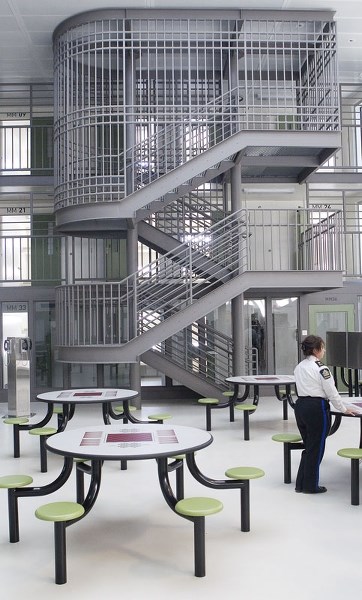Located at 127 Street north of the Anthony Henday, Edmonton’s new remand centre is only a stone’s throw from St. Albert.
But that need not worry anyone.
The centre is a high-security facility with little access to the outside thanks to computerized visits, identification wristbands and direct supervision.
The $580-million building opened its doors to the public and media last week, So many people wanted a glimpse that 30-minute lineups extended from the entrance to the Henday.
Come mid-April, the only people going in and out will be inmates and guards. The 16-hectare site will house 1,200 to 1,400 inmates, with a maximum capacity of 1,952.
That’s more than twice the capacity of the current remand centre in Edmonton.
The inmates will live in a network of five pods. Each pod is separated into four units, holding 72 people (the mental health ward holds 68).
The maximum security pod houses 288 inmates, each in a separate room.
Another unit holds only eight people, those with such a high media profile that they can’t be kept with the rest of the inmate population.
The centre has room to build three more pods should it ever run out of space, allowing for a total of 2,816 inmates.
Each unit has an exercise room with access to the outside, an information kiosk (to look up the meal plan or library books), and a few tables with chess and solitaire games.
Meals are heated in a warming unit next to a juice and water dispenser. The food is said to be nutritious, but not delicious.
Each cell houses two inmates, with a bunk for each. There are two seats and a table built into the wall, a mirror, a wash basin, a toilet and two windows.
The windows allow for natural light. But Melody Kotyk, program manager for Alberta provincial corrections, said it’s impossible for inmates to stick their heads through the 15-centrimetre wide slots.
Except for soft green chairs and doors, the units are white.
“They picked this colour because sage green is supposed to be therapeutic and healing,” Kotyk said.
“It’s a nice change for us.”
Instead of the old-fashioned, personal procedure for visits, inmates now see their loved ones on one of four video conferencing stations located in each unit. They communicate using technology similar to Skype.
There are also 32 video booths designed for court appearances.
If inmates try to flash someone, the video is turned off. The same rule applies to the visitors who go to the visitors’ centre on 170th Street to communicate with inmates inside the remand centre.
Long-term inmates and those with a special reason like a death or birth in the family can still apply for an in-person visit.
The centre operates with a system of direct supervision. Two correction officers sit behind a desk inside each unit, instead of being separated from the inmates by glass.
Kotyk said direct supervision builds better relationships between inmates and guards, and causes fewer incidents. She compares the system to an elementary school.
If the teacher wanders around between the desks, it’s easier to ask for help.
“When you put the teacher at the front of the classroom, it’s more intimidating to leave your desk and ask the same question,” she said.
“If you go away from direct supervision and make it indirect, that puts the teacher in the hallway so they can see into the classroom but nobody is asking for any assistance.”
Kotyk added that correctional officers are highly trained and can often talk themselves out of dangerous situations instead of having to resort to violence.
But there’s also one more officer in the “pod control,” a surveillance room that oversees each pod.
Staff carry radios with emergency buttons to call for assistance (some also have pepper spray secured to their belts) and the general response time for help is under 30 seconds.
Upon arrival at the remand centre, inmates receive a bracelet with a barcode that has their name, offender number, birthday and photo on it.
Kotyk said the bands help with identification and medication.
“You may imagine, some people like someone else’s medication more than their own. So this way we are following hospital bed practices,” she said, adding that their strongest guard was not able to break the wristband.
Male inmates wear new orange jumpsuits, while the small female population (about 50 at any time) keeps their navy-blue sweat suits.
Inmates also receive a bedroll, toiletries and extra clothing, and are searched when arriving at the centre.
On laundry day (once a week), dirty clothes are clipped to a loop with a number attached. Kotyk said no one in the laundry knows what number belongs to what inmate.
In case of injury or alcohol withdrawal, the centre has its own infirmary. There’s also a medical clinic with an X-ray machine and access to oxygen in each treatment room.
One patient wing even has removable bunk beds, for those in danger of falling out of bed.
The centre is expected to open in mid-April. An exact date was not provided for security reasons.




